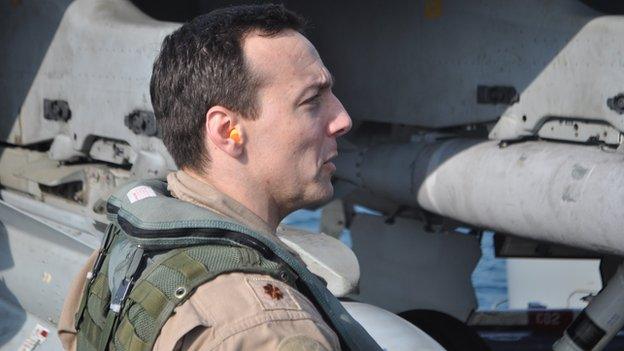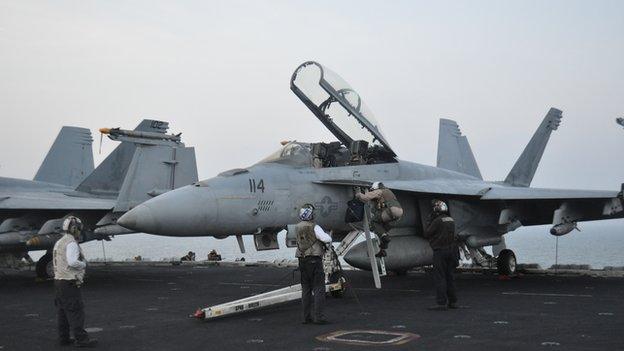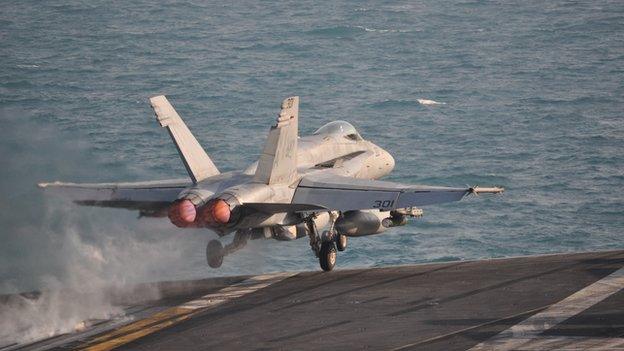On board with the US air crews fighting Islamic State
- Published
USS Carl Vinson is at the centre of operations against IS
How is progress measured on board the US aircraft carrier which is playing a key role in the fight against Islamic State?
The aircraft carrier USS Carl Vinson, plying the waters of the Gulf, represents a big slice of the coalition effort being used to pound the self-proclaimed Islamic State in Syria and Iraq - an onslaught that has been going on for the best part of five months now.
It is a floating town of more than 5,000 souls and 60 fighter aircraft engaged in a costly and complex campaign.
Each time it launches one of its jets, catapulting it over the green waters south of Iran, the event is so dramatic and inherently dangerous that it would be understandable if many a spectator forgot the question - is this air offensive working?
It's extremely hard for Western reporters to seek the answers to that on the ground, in Mosul or Raqqa. But we can be on board the carrier, speaking to those carrying out this operation, as I was for four days, gauging their sense of the task, its challenges, and whether it's achieving results.
Distinctly slow
The US President gave his forces the mission of degrading and destroying the Islamic State and, "we're working at it a couple of bodies at a time," Capt Karl Thomas, the ship's commanding officer, says with deadpan frankness.
And that statement embraces both the sense that there is forward movement, but also that for many conducting this business, it is distinctly slow.
USS Carl Vinson has been flying missions in support of Operation Inherent Resolve, as the US calls its effort against Islamic State, for two and a half months, and has already clocked up more than 1,000 strike missions.
Most of these have been flown over Iraq (closer to the Gulf waters where she cruises than Syria). But in how many cases have the aircraft actually had good enough information to launch weapons, safely, against a target on the ground?

Lt Cmdr 'Mike' said he had not launched any weapons during his mission
The exact figure is classified. Early on during this operation, it was estimated that only a small minority of strike missions were using their weapons, perhaps 10%.
Lt Junior Grade "Sarah" a 29-year-old weapon systems operator or back seater in an F/A-18F fighter, told me she had "employed…on around 40%" of her missions. Some of those we met, like her, asked us not to use their real names.
I spoke to Sarah shortly after her aircraft returned from Iraq minus two of its laser-guided bombs, and she had given a celebratory high five to her crew chief waiting on the carrier. Before she had taken off, the lieutenant told her: "I hope we come back with fewer bombs".
There is a coyness among the crews - in front of us at least - about wanting to appear too keen to take life, but after completing the mission, she said, "when we do get to employ out there it's very exciting".
Of course commanders are wary of the crude metric of how many bombs are dropped and Capt Matt Leahey, leading the air wing aboard the carrier, tells his crews, "the weapon you bring back is sometimes the most important one," since dropping one in error could have terrible consequences.
Weapons resupplied
While Capt Leahey declined to discuss specific figures of how many of those 1,000 plus strike missions from the ship had "employed" or exactly what types of weapons they used, it is clear that the proportion has gone up since Op Inherent Resolve's early days. During one replenishment from a stores ship we watched 144 new bombs being brought on board the USS Carl Vinson.
Bringing on more ordnance was, "always a good sign" quipped Capt Thomas, noting that it meant 144 bombs had been dropped. And what we witnessed was just one of many re-supply serials since the ship's cruise, planned to last nine and a half months, began.
Producing these air strikes requires the ship to operate myriad interlinked operations every day, launching and recovering its aircraft in a complex and inherently dangerous ballet. Typically, missions over Iraq last five or six hours, requiring the pilots to refuel in flight four times.

Over Iraq or Syria the planes orbit in a "stack," waiting to be given a target by the JTAC (pronounced 'J-tac', it stands for Joint Terminal Air Controller, the person who makes the decision about engaging the enemy, directing the air crews onto them).
During the long Afghan campaign the JTAC was often someone on the ground, directly under enemy fire. In this new operation there are some on the ground (for example coalition special forces) but most JTACs are either aloft in other aircraft or sitting in an operations centre, watching the downlinks from Reapers and other drones.
Controllers can often keep a jet circling for hours before letting it return to base, weapons unused. But whether it drops multiple bombs or none, the effort involved in launching each mission is considerable and fraught with hazards.
"Every flight there is a risk out there," notes Lt Cdr "Mike," who at 35 is one of the veteran pilots on board. It starts with being catapulted off the deck, goes through the in-flight fuel top ups, which he notes "can be unpleasant," flying in close proximity to the tanker in bad weather or at night, and ends with the "controlled car crash" of recovering the jet onto the carrier.
Risks
I watched Lt Cdr Mike's F/A18F land at night on the Vinson's deck after a seven-hour mission over Iraq. As the plane came in at what seemed like an impossibly steep angle and at 160mph, I remembered reading an old carrier pilot's quip that during such recoveries in the hours of darkness, "there are no atheists in the cockpit".
A couple of the aircraft before his had failed to hook on to the carrier's arresting wires, and roared back into the inky sky, but Mike, Top Gun pilot that he is, managed it flawlessly, hooking on to the cable and stopping his jet in a few gut-wrenching seconds.
Below deck I asked whether he had launched any weapons? "No, it had been bad weather, no targets identified," he replied. What was his first priority at that moment? "Probably it's the rest room then the second one would be to eat".

Spending five or more hours strapped to an ejector seat, unable to get up or use a toilet, must be a distinctly unpleasant experience at times. The pilots take snacks and "piddle packs" to relieve themselves into. But of course these discomforts are mundane compared to the dangers of going down over IS-controlled territory, as a Jordanian pilot recently did, or crashing during carrier operations.
During its journey to the Gulf, the Carl Vinson lost two F/A18 Hornets that collided near the carrier. One pilot was recovered but the other was lost at sea.
The crews are all too aware of the risks but are uneasy discussing them with an outsider. "It's not something we like to think about," Lt Sarah said about the risks of getting shot down. Clearly though, it informed her decision not to use her name when interviewed.
'Making progress'
Those commanding the operations on board are quite sure they are making progress. "Absolutely the situation has changed since airstrikes began", says Cmdr Mike Langbehn, boss of one of the Hornet squadrons, noting "in the early reports before we got on station, they were much more brazen".
Cdr Langbehn and others now see the militants being far more careful about massing their forces, since doing so presents the coalition with a tempting target.
The days of IS making sweeping gains were over and their progress has been halted, several officers said. "They swept through the country, now they're not," commented Capt Thomas.
At the level of the individual pilot or weapon system operator though, without the intelligence briefings available to their bosses, the sense of progress is less tangible.
Rather, Lt Sarah says, they prefer to break a mission down into its component parts, focusing on each in turn, trying to perform them all correctly day after day. "It's going to take time, it's going to take very precise strikes," says Lt Cdr Mike, before reiterating, "it's going to take a while".
As the strikes have gone on, hundreds of bombs and missiles have been launched from the Vinson's aircraft. In places a building has been hit, in others a checkpoint or one of the Humvees taken from the Iraqi forces last year by IS has been blown up.
If the character of this air operation is deliberate and slow, that's why the commanding officer talks about working it a few bodies at a time.
Another officer on board told me he would bet that the carrier on station after Vinson heads homewards in a few months, and the one after that would also be flying missions in support of Op Inherent Resolve. For the US Navy's carrier aviators then, this looks set to become the new normal.